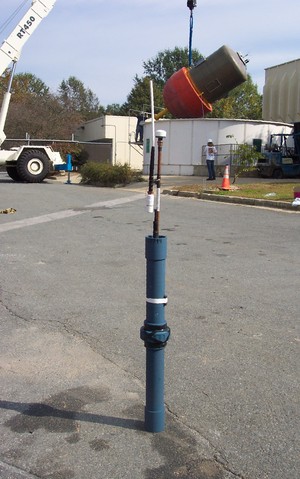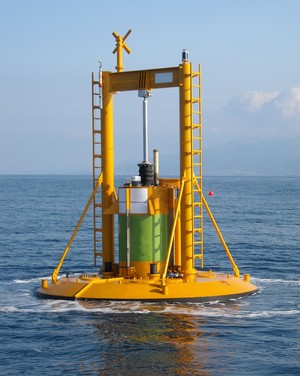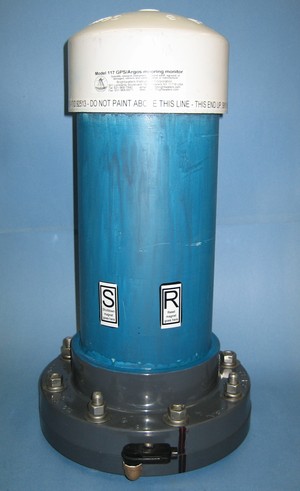
Model 117 GPS/Argos mooring monitor with "tickle trickle" option being delivered to provide backup location service to deep sea telemetry buoy in background.
click on image to enlarge

Model 117 mounted on wave power buoy
(top of left pylon)
click on image to enlarge

Model 117 low profile case option
click on image to enlarge
|
The Brightwaters Model 117 GPS/Argos mooring monitor is a self-contained, self- powered device designed to be attached to the surface buoy of a mooring in a body of water. The monitor determines its location using GPS and compares this location to a stored "anchor watch" position. If the mooring breaks free and begins to drift, the monitor activates a radio transmitter and begins to send the position of the mooring to the end user. This radio telemetry is accomplished using the joint US/France Argos satellite system. Using Argos provides worldwide data collection service and email notification direct to the end user if a mooring breaks free.
The Model 117's smart monitoring technology provides considerable cost advantages over the traditional Moored Buoy Monitoring Service (MBM) offered by Argos/NACLS. MBM service involves continuous transmission by an Argos PTT mounted to the mooring at a cost of about $7 USD per day monitoring and $50 - $70 per day when in alarm/tracking mode. The Model 117 doesn't use the satellite at all unless it needs to send an alarm or status signal. Instead of MBM service, the Model 117 uses the Argos "location and position" service, which costs nothing in monitoring mode and $10 - $30 per day on days when status or alarm/position signals are sent. Savings on satellite charges alone will pay back the purchase price of the Model 117 in less than one year of use.
Although the end user can extensively test and reprogram the operational characteristics of the monitor via an RS232 (serial) data connection to a user-supplied laptop computer, basic operation of the monitor is extremely simple. The monitor is attached to the surface marker of the mooring. Immediately before the mooring deployment, an external shutdown magnet is removed. The monitor activates and begins a countdown to position determination (default 3 hours). At the conclusion of the countdown (presumably the mooring is now in place) the monitor powers up and initializes its GPS unit. Over a period of 12 hours (user selectable) the monitor takes hourly GPS position readings and uses them to determine an "average" location for the mooring. After this initialization period, the monitor checks GPS position once per hour. If three GPS positions in a row are invalid or fall outside a selected "watch box" distance from the stored average position, the monitor changes from "monitoring" to "alarm" mode.
In alarm mode, every 90 seconds the monitor transmits a compressed time series of GPS positions using an Argos-2 Platform Transmitter Terminal (PTT). By using three interleaved messages (a technique developed by Brightwaters) the most recent GPS positions and up to 20 previous hourly positions can be sent through Argos to the end user. Argos satellites pass over every spot on earth from 6 to 26 times per day (depending on latitude). If the monitor is transmitting the coded positions will be received and forwarded by email to the end user, often within minutes and at most only a couple of hours behind real time.
When setting up a program with Service Argos the end user typically specifies their personal email address as the recipient for monitor data. If an end user starts receiving emailed data from a monitor, they feed the email to a supplied program, which decodes the compressed Argos data into a series of hourly GPS positions. A recovery team can then be dispatched to the area of the drifting mooring. Once the team comes within a few miles of the mooring's location, an uplink receiver can be used to directly receive the PTT transmissions in real time and home in on the drifting mooring.
The Model 117 can be programmed to transmit a regular status message to verify proper operation. It is suggested that this feature be used once every 7 to 10 days both to save batteries and satellite charges, since Argos will charge from $10 - $30 on any day that the satellite receives a transmission, even if just for one message.
External materials are PVC, copper, and stainless steel, with full galvanic isolation allowing mounting to any buoy material without fear of galvanic corrosion. Antennas do not require any ground plane connections to the main buoy body. Weight in air is approximately 30 pounds. Two physical packages are available.
- The standard case is intended to fit along a leg of a surface buoy tower. Approximate size is 4 inches in diameter x 36 inches long, with a 6 inch diameter closure ring located approximately midway on the hull. A mast holding GPS and Argos antennas projects upward from the hull to an additional height of 20 inches. Location of the monitor on the side of a structure is non-critical so long as there is a reasonable sky view.
- The more robust low profile case is intended to bolt to a base plate on top of a buoy. The case can accommodate up to three battery packs for extended endurance.
Additional options for the Model 117 include:
- A double battery pack option providing extended operational endurance for the standard case. This option extends the case length by an additional 12 inches.
- Submersible case for use on aquaculture cages that are purposely sunk in advance of storm events.
- Remote pressure sensor that sounds an alarm if freeboard drops below a user adjustable value.
- External inputs that can trigger alarms (power loss in external equipment) or be transmitted in scheduled status messages (aquaculture fish food level).
- External "tickle-trickle" watchdog input that keeps the Model 117 completely asleep until external equipment fails. The external system sends a pulse "tickle" signal at a selectable interval from minutes to hours. If the "tickle" stops coming, the Model 117 wakes up and begins normal operation. If desired, a micropower "trickle" supply voltage can be supplied (from external solar power, for example) resulting in zero load on the internal batteries. Use of the "tickle-trickle" option can greatly extend the endurance of the Model 117 when it is used as a backup locator on buoys with their own telemetry and positioning systems.
Battery packs are constructed from standard alkaline "D" cells to avoid the costs and transport restrictions associated with lithium cells. Endurance of the monitor using a single battery pack under default conditions of 1 position check per hour would be 4 months monitoring followed by 21 days of alarm transmission.
As an optional value added service, Brightwaters can be designated as an additional recipient of emailed alarm/status data from the Model 117 monitors. Our automated server will check for alarm transmissions from the monitors every 15 minutes, 24 hours per day, 365 days per year. If an alarm transmission is detected, our server will automatically decode the latest GPS positions and email them as plain text to the end user(s). The server can also send alarm notifications direct to an alphanumeric pager or cell phone if desired. Monthly cost of this service depends on the number of monitors being checked and the notification methods desired. If interested please contact Brightwaters for further particulars.
Model 117 flyer in .PDF format (231 KB).
|


![]()

